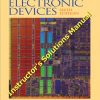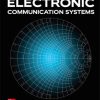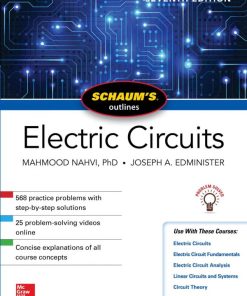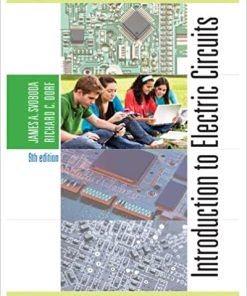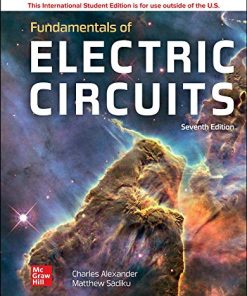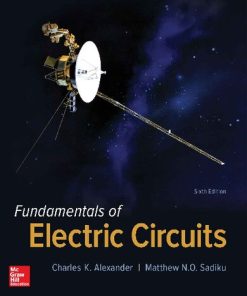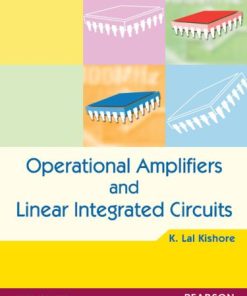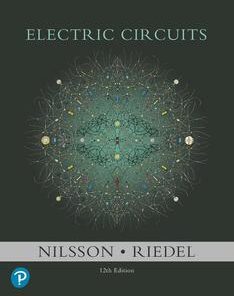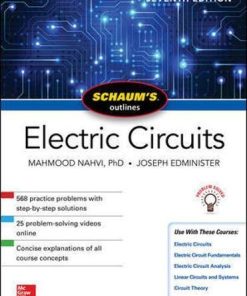(Ebook PDF) Fundamentals of electric circuits 6th Edition by Charles Alexander, Matthew Sadiku 0078028221 978-0078028229 full chapters
$50.00 Original price was: $50.00.$25.00Current price is: $25.00.
Fundamentals of electric circuits 6th Edition by Charles Alexander, Matthew Sadiku – Ebook PDF Instant Download/DeliveryISBN: 0078028221, 978-0078028229
Full dowload Fundamentals of electric circuits 6th Edition after payment.
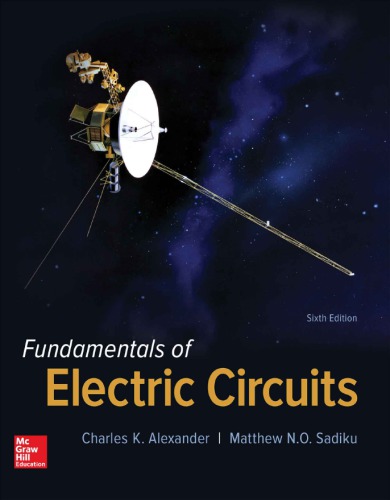
Product details:
ISBN-10 : 0078028221
ISBN-13 : 978-0078028229
Author: Charles Alexander, Matthew Sadiku
Fundamentals of Electric Circuits continues in the spirit of its successful previous editions, with the objective of presenting circuit analysis in a manner that is clearer, more interesting, and easier to understand than other, more traditional texts. Students are introduced to the sound, six-step problem solving methodology in chapter one, and are consistently made to apply and practice these steps in practice problems and homework problems throughout the text. A balance of theory, worked & extended examples, practice problems, and real-world applications, combined with over 468 new or changed homework problems complete this edition. Robust media offerings, renders this text to be the most comprehensive and student-friendly approach to linear circuit analysis out there. This book retains the “Design a Problem” feature which helps students develop their design skills by having the student develop the question, as well as the solution. There are over 100 “Design a Problem” exercises integrated into problem sets in the book.
Fundamentals of electric circuits 6th Table of contents:
PART 1 DC Circuits 2
Chapter 1 Basic Concepts 3
1.1 Introduction 4
1.2 Systems of Units 4
1.3 Charge and Current 6
1.4 Voltage 9
1.5 Power and Energy 10
1.6 Circuit Elements 15
1.7 Applications 17
1.7.1 TV Picture Tube
1.7.2 Electricity Bills
1.8 Problem Solving 20
1.9 Summary 23
Review Questions 24
Problems 24
Comprehensive Problems 27
Chapter 2 Basic Laws 29
2.1 Introduction 30
2.2 Ohm’s Law 30
2.3 Nodes, Branches, and Loops 35
2.4 Kirchhoff’s Laws 37
2.5 Series Resistors and Voltage Division 43
2.6 Parallel Resistors and Current Division 45
2.7 Wye-Delta Transformations 52
2.8 Applications 58
2.8.1 Lighting Systems
2.8.2 Design of DC Meters
2.9 Summary 64
Review Questions 66
Problems 67
Comprehensive Problems 78
Chapter 3 Methods of Analysis 81
3.1 Introduction 82
3.2 Nodal Analysis 82
3.3 Nodal Analysis with Voltage Sources 88
3.4 Mesh Analysis 93
3.5 Mesh Analysis with Current Sources 98
3.6 Nodal and Mesh Analyses by Inspection 100
3.7 Nodal Versus Mesh Analysis 104
3.8 Circuit Analysis with PSpice 105
3.9 Applications: DC Transistor Circuits 107
3.10 Summary 112
Review Questions 113
Problems 114
Comprehensive Problems 126
Chapter 4 Circuit Theorems 127
4.1 Introduction 128
4.2 Linearity Property 128
4.3 Superposition 130
4.4 Source Transformation 135
4.5 Thevenin’s Theorem 139
4.6 Norton’s Theorem 145
4.7 Derivations of Thevenin’s and Norton’s Theorems 149
4.8 Maximum Power Transfer 150
4.9 Verifying Circuit Theorems with PSpice 152
4.10 Applications 155
4.10.1 Source Modeling
4.10.2 Resistance Measurement
4.11 Summary 160
Review Questions 161
Problems 162
Comprehensive Problems 173
Chapter 5 Operational Amplifi;ers 175
5.1 Introduction 176
5.2 Operational Amplifiers 176
5.3 Ideal Op Amp 179
5.4 Inverting Amplifier 181
5.5 Noninverting Amplifier 183
5.6 Summing Amplifier 185
5.7 Difference Amplifier 187
5.8 Cascaded Op Amp Circuits 191
5.9 Op Amp Circuit Analysis with PSpice
5.10 Applications 196
5.10.1 Digital-to-Analog Converter
5.10.2 Instrumentation Amplifiers
5.11 Summary 199
Review Questions 201
Problems 202
Comprehensive Problems 213
Chapter 6 Capacitors and Inductors 215
6.1 Introduction 216
6.2 Capacitors 216
6.3 Series and Parallel Capacitors 220
6.4 Inductors 226
6.5 Series and Parallel Inductors 229
6.6 †Applications 233
6.6.1 Integrator
6.6.2 Differentiator
6.6.3 Analog Computer
6.7 Summary 240
Review Questions 241
Problems 242
Comprehensive Problems 251
Chapter 7 First-Order Circuits
7.1 Introduction 254
7.2 The Source-Free RC Circuit 254
7.3 The Source-Free RL Circuit 259
7.4 Singularity Functions 265
7.5 Step Response of an RC Circuit 273
7.6 Step Response of an RL Circuit 276
7.7 First-Order Op Amp Circuits 280
7.8 Transient Analysis with PSpice 298
7.9 Applications 293
7.9.1 Delay Circuits
7.9.2 Photoflash Unit
7.9.3 Relay Circuits
7.9.4 Automobile Ignition Circuit
7.10 Summary 299
Review Questions 300
Problems 301
Comprehensive Problems 311
Chapter 8 Second-Order Circuits 313
8.1 Introduction 314
8.2 Finding Initial and Final Values 314
8.3 The Source-Free Series RLC Circuit 319
8.4 The Source-Free Parallel RLC Circuit 326
8.5 Step Response of a Series RLC Circuit 331
8.6 Step Response of a Parallel RLC Circuit 336
8.7 General Second-Order Circuits 339
8.8 Second-Order Op Amp Circuits 344
8.9 PSpice Analysis of RLC Circuits 346
8.10 Duality 350
8.11 Applications 353
8.11.1 Automobile Ignition System
8.11.2 Smoothing Circuits
8.12 Summary 356
Review Questions 357
Problems 358
Comprehensive Problems 367
PART 2 AC Circuits 368
Chapter 9 Sinusoids and Phasors 369
9.1 Introduction 370
9.2 Sinusoids 371
9.3 Phasors 376
9.4 Phasor Relationships for Circuit Elements 385
9.5 Impedance and Admittance 387
9.6 Kirchhoff’s Laws in the Frequency Domain 389
9.7 Impedance Combinations 390
9.8 Applications 396
9.8.1 Phase-Shifters
9.8.2 AC Bridges
9.9 Summary 402
Review Questions 403
Problems 403
Comprehensive Problems 411
Chapter 10 Sinusoidal Steady-State Analysis 413
10.1 Introduction 414
10.2 Nodal Analysis 414
10.3 Mesh Analysis 417
10.4 Superposition Theorem 421
10.5 Source Transformation 424
10.6 Thevenin and Norton Equivalent Circuits 426
10.7 Op amp AC Circuits 431
10.8 AC Analysis Using PSpice 433
10.9 Applications 437
10.9.1 Capacitance Multiplier
10.9.2 Oscillators
10.10 Summary 441
Review Questions 441
Problems 443
Chapter 11 AC Power Analysis
11.1 Introduction 458
11.2 Instantaneous and Average Power 458
11.3 Maximum Average Power Transfer 464
11.4 Effective or RMS Value 467
11.5 Apparent Power and Power Factor 470
11.6 Complex Power 473
11.7 Conservation of AC Power 477
11.8 Power Factor Correction 481
11.9 Applications 483
11.9.1 Power Measurement
11.9.2 Electricity Consumption Cost
11.10 Summary 488
Review Questions 490
Problems 490
Comprehensive Problems 500
Chapter 12 Three-Phase Circuits 503
12.1 Introduction 504
12.2 Balanced Three-Phase Voltages 505
12.3 Balanced Wye-Wye Connection 509
12.4 Balanced Wye-Delta Connection 512
12.5 Balanced Delta-Delta Connection 514
12.6 Balanced Delta-Wye Connection 516
12.7 Power in a Balanced System 519
12.8 Unbalanced Three-Phase Systems 525
12.9 PSpice for Three-Phase Circuits 529
12.10 Applications 534
12.10.1 Three-Phase Power Measurement
12.10.2 Residential Wiring
12.11 Summary 543
Review Questions 543
Problems 544
Comprehensive Problems 553
Chapter 13 Magnetically Coupled Circuits 555
13.1 Introduction 556
13.2 Mutual Inductance 557
13.3 Energy in a Coupled Circuit 564
13.4 Linear Transformers 567
13.5 Ideal Transformers 573
13.6 Ideal Autotransformers 581
13.7 Three-Phase Transformers 584
13.8 PSpice Analysis of Magnetically
13.9 Coupled Circuits 586 †Applications 591
13.9.1 Transformer as an Isolation Device
13.9.2 Transformer as a Matching Device
13.9.3 Power Distribution
13.10 Summary 597
Review Questions 598
Problems 599
Comprehensive Problems 611
Chapter 14 Frequency Response 613
14.1 Introduction 614
14.2 Transfer Function 614
14.3 The Decibel Scale 617
14.4 Bode Plots 619
14.5 Series Resonance 629
14.6 Parallel Resonance 634
14.7 Passive Filters 637
14.7.1 Lowpass Filter
14.7.2 Highpass Filter
14.7.3 Bandpass Filter
1 4.7.4 Bandstop Filter
14.8 Active Filters 642
14.8.1 First-Order Lowpass Filter
14.8.2 First-Order Highpass Filter
14.8.3 Bandpass Filter
14.8.4 Bandreject (or Notch) Filter
14.9 Scaling 648
14.9.1 Magnitude Scaling
14.9.2 Frequency Scaling
14.9.3 Magnitude and Frequency Scaling
14.10 Frequency Response Using PSpice 652
14.11 Computation Using MATLAB 655
14.12 Applications 65717.3 Symmetry Considerations 764
14.12.1 Radio Receiver17.3.1 Even Symmetry
14.12.2 Touch-Tone Telephone17.3.2 Odd Symmetry
14.12.3 Crossover Network17.3.3 Half-Wave Symmetry
14.13 Summary 663
Review Questions 664
Problems 665
Comprehensive Problems 673
PART 3 Advanced Circuit Analysis 674
Chapter 15 Introduction to Laplace Transforms 675
15.1 Introduction 676
15.2 Definition of the Laplace Transform 677
15.3 Properties of the Laplace Transform 679
15.4 The Inverse Laplace Transform 690
15.4.1 Simple Poles
15.4.2 Repeated Poles
15.4.3 Complex Poles
15.5 The Convolution Integral 697
15.6 Application to Integrodifferential Equations 705
Summary 708
Review Questions 708
Problems 709
Chapter 16 Applications of the Laplace Transform 715
16.1 Introduction 716
16.2 Circuit Element Models 716
16.3 Circuit Analysis 722
16.4 Transfer Functions 726
16.5 State Variables 730
16.6 Applications 737
16.6.1Network Stability
16.6.2Network Synthesis
16.7 Summary 745
Review Questions 746
Problems 747
Comprehensive Problems 754
Chapter 17 The Fourier Series 755
17.1 Introduction 756
17.2 Trigonometric Fourier Series 756
17.4 Circuit Applications 774
17.5 Average Power and RMS Values 778
17.6 Exponential Fourier Series 781
17.7 Fourier Analysis with PSpice 787
17.7.1 Discrete Fourier Transform
17.7.2 Fast Fourier Transform
17.8 Applications 793
17.8.1 Spectrum Analyzers
17.8.2 Filters
17.9 Summary 796
Review Questions 798
Problems 798
Comprehensive Problems 807
Chapter 18 Fourier Transform 809
18.1 Introduction 810
18.2 Definition of the Fourier Transform 810
18.3 Properties of the Fourier Transform 816
18.4 Circuit Applications 829
18.5 Parseval’s Theorem 832
18.6 Comparing the Fourier and Laplace Transforms 835
18.7 Applications 836
18.7.1 Amplitude Modulation
18.7.2 Sampling
18.8 Summary 839
Review Questions 840
Problems 841
Comprehensive Problems 847
Chapter 19 Two-Port Networks 849
19.1 Introduction 850
19.2 Impedance Parameters 850
19.3 Admittance Parameters 855
19.4 Hybrid Parameters 858
19.5 Transmission Parameters 863
19.6 Relationships Between Parameters 868
19.7 Interconnection of Networks 871
19.8 Computing Two-Port Parameters Using PSpice 877
19.9 Applications 880
19.9.1 Transistor Circuits
19.9.2 Ladder Network Synthesis
19.10 Summary 889
People also search for Fundamentals of electric circuits 6th:
sadiku fundamentals of electric circuits
fundamentals of electric circuits solutions
fundamentals of electric circuits 7th edition reddit
fundamentals of electric circuits 8th edition
fundamentals of electric circuits 7th edition chegg
You may also like…
Engineering - Electrical & Electronic Engineering
Schaum’s Outline of Electric Circuits 7th Edition Mahmood Nahvi
Uncategorized
Engineering
(Ebook PDF) Electric Circuits 1st Edition by James Kang ISBN 9798214342030 1305635213 full chapters
Engineering - Electrical & Electronic Engineering
Fundamentals of Electric Circuits 7th (International Student Edition) Charles K. Alexander
Engineering - Electrical & Electronic Engineering
Engineering - Engineering Technology
Operational Amplifiers and Linear Integrated Circuits K. Lal. Kishore
Engineering - Electrical & Electronic Engineering


